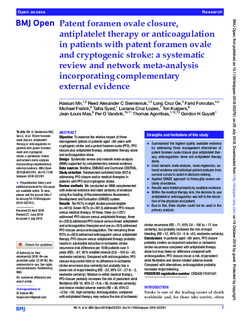| dc.contributor.author | Mir, Hassan | |
| dc.contributor.author | Siemieniuk, Reed Alexander C. | |
| dc.contributor.author | Ge, Long Cruz | |
| dc.contributor.author | Foroutan, Farid | |
| dc.contributor.author | Fralick, Michael | |
| dc.contributor.author | Syed, Talha | |
| dc.contributor.author | Lopes, Luciane Cruz | |
| dc.contributor.author | Kuijpers, Ton | |
| dc.contributor.author | Mas, Jean-Louis | |
| dc.contributor.author | Vandvik, Per Olav | |
| dc.contributor.author | Agoritsas, Thomas | |
| dc.contributor.author | Guyatt, Gordon H | |
| dc.coverage.spatial | Norway | nb_NO |
| dc.date.accessioned | 2018-11-21T11:48:58Z | |
| dc.date.available | 2018-11-21T11:48:58Z | |
| dc.date.created | 2018-10-19T13:48:13Z | |
| dc.date.issued | 2018 | |
| dc.identifier.citation | Mir H, Siemieniuk RAC, Ge LC, et al. Patent foramen ovale closure, antiplatelet therapy or anticoagulation in patients with patent foramen ovale and cryptogenicstroke: a systematic review and network meta-analysis incorporating complementary external evidence. BMJ Open 2018;8:e023761. doi:10.1136/bmjopen-2018-023761 | nb_NO |
| dc.identifier.issn | 2044-6055 | |
| dc.identifier.uri | http://hdl.handle.net/11250/2574113 | |
| dc.description.abstract | OBJECTIVE:
To examine the relative impact of three management options in patients aged <60 years with cryptogenic stroke and a patent foramen ovale (PFO): PFO closure plus antiplatelet therapy, antiplatelet therapy alone and anticoagulation alone.
DESIGN:
Systematic review and network meta-analysis (NMA) supported by complementary external evidence.
DATA SOURCES:
Medline, EMBASE and Cochrane CENTRAL.
STUDY SELECTION:
Randomised controlled trials (RCTs) addressing PFO closure and/or medical therapies in patients with PFO and cryptogenic stroke.
REVIEW METHODS:
We conducted an NMA complemented with external evidence and rated certainty of evidence using the Grading of Recommendations Assessment, Development and Evaluation (GRADE) system.
RESULTS:
Ten RCTs in eight studies proved eligible (n=4416). Seven RCTs (n=3913) addressed PFO closure versus medical therapy. Of these, three (n=1257) addressed PFO closure versus antiplatelet therapy, three (n=2303) addressed PFO closure versus mixed antiplatelet and anticoagulation therapies and one (n=353) addressed PFO closure versus anticoagulation. The remaining three RCTs (n=503) addressed anticoagulant versus antiplatelet therapy. PFO closure versus antiplatelet therapy probably results in substantial reduction in ischaemic stroke recurrence (risk difference per 1000 patients over 5 years (RD): -87, 95% credible interval (CrI) -100 to -33; moderate certainty). Compared with anticoagulation, PFO closure may confer little or no difference in ischaemic stroke recurrence (low certainty) but probably has a lower risk of major bleeding (RD -20, 95% CrI -27 to -2, moderate certainty). Relative to either medical therapy, PFO closure probably increases the risk of persistent atrial fibrillation (RD 18, 95% CI +5 to +56, moderate certainty) and device-related adverse events (RD +36, 95% CI +23 to +50, high certainty). Anticoagulation, compared with antiplatelet therapy, may reduce the risk of ischaemic stroke recurrence (RD -71, 95% CrI -100 to +17, low certainty), but probably increases the risk of major bleeding (RD +12, 95% CrI -5 to +65, moderate certainty).
CONCLUSIONS:
In patients aged <60 years, PFO closure probably confers an important reduction in ischaemic stroke recurrence compared with antiplatelet therapy alone but may make no difference compared with anticoagulation. PFO closure incurs a risk of persistent atrial fibrillation and device-related adverse events. Compared with alternatives, anticoagulation probably increases major bleeding.
PROSPERO REGISTRATION NUMBER: CRD42017081567. | nb_NO |
| dc.description.sponsorship | This research received no specific grant from any funding agency in the public, commercial or not-for-profit sectors. | nb_NO |
| dc.language.iso | eng | nb_NO |
| dc.relation.uri | https://bmjopen.bmj.com/content/bmjopen/8/7/e023761.full.pdf | |
| dc.rights | Attribution-NonCommercial-NoDerivatives 4.0 Internasjonal | * |
| dc.rights.uri | http://creativecommons.org/licenses/by-nc-nd/4.0/deed.no | * |
| dc.subject | anticoagulation | nb_NO |
| dc.subject | antiplatelet | nb_NO |
| dc.subject | cryptogenic stroke | nb_NO |
| dc.subject | patent foramen ovale | nb_NO |
| dc.subject | pfo closure | nb_NO |
| dc.title | Patent foramen ovale closure, antiplatelet therapy or anticoagulation in patients with patent foramen ovale and cryptogenic stroke: a systematic review and network meta-analysis incorporating complementary external evidence | nb_NO |
| dc.title.alternative | Patent foramen ovale closure, antiplatelet therapy or anticoagulation in patients with patent foramen ovale and cryptogenic stroke: a systematic review and network meta-analysis incorporating complementary external evidence | nb_NO |
| dc.type | Journal article | nb_NO |
| dc.type | Peer reviewed | nb_NO |
| dc.description.version | publishedVersion | nb_NO |
| dc.rights.holder | This is an open access article distributed in accordance with the Creative Commons Attribution Non Commercial (CC BY-NC 4.0) license, which permits others to distribute, remix, adapt, build upon this work non-commercially, and license their derivative works on different terms, provided the original work is properly cited, appropriate credit is given, any changes made indicated, and the use is non-commercial. See: http:// creativecommons. org/ licenses/ by- nc/ 4. 0/. Published by BMJ. | nb_NO |
| dc.source.pagenumber | 15 | nb_NO |
| dc.source.volume | 8 | nb_NO |
| dc.source.journal | BMJ Open | nb_NO |
| dc.source.issue | 7 | nb_NO |
| dc.identifier.doi | 10.1136/bmjopen-2018-023761 | |
| dc.identifier.cristin | 1621740 | |
| cristin.unitcode | 1991,0,0,0 | |
| cristin.unitname | Sykehuset Innlandet HF | |
| cristin.ispublished | true | |
| cristin.fulltext | original | |
| cristin.qualitycode | 1 | |

